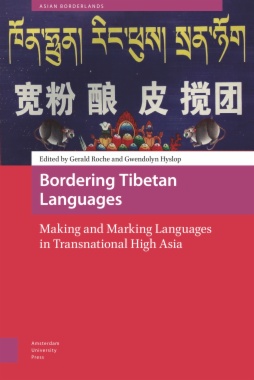Bordering Tibetan Languages: Making and Marking Languages in Transnational High Asia examines the complex interactions between state, ethnic, and linguistic borders in the Himalayas. These case studies from Bhutan, China, India, and Nepal show how people in the Himalayas talk borders into existence, and also how those borders speak to them and their identities. These ‘talking borders’ exist in a world where state borders are contested, and which is being irrevocably transformed by rapid social and economic change. This book offers a new perspective on this dynamic region by centring language, and in doing so, also offers new ways of thinking about how borders and language influence each other.
- Cover
- Table of Contents
- Acknowledgements
- About the Cover Image
- 1 Introduction: Bordering Tibetan Languages
- Making and Marking Languages in Transnational High Asia
- 2 Playing with Language Boundaries
- Heteroglot Standard Language Ideology and Linguistic Belonging among Amdo Children
- 3 The Role of Classical Tibetan (Chöke) on the Development of Kurtöp, a Language of Bhutan
- 4 Reimagining Rongring without Tibetan Buddhist Influence
- 5 Glottonyms, Identity, and Language Recognition in the Eastern Tibetosphere
- 6 On the Yak Horns of a Dilemma
- Diverging Standards in Diaspora Tibetan
- 7 Changing Identity and Linguistic Practices in Nubri
- Veiled Language Endangerment in the Nepalese Tibetosphere
- 8 Borderline Dominance
- Transnational Tibetan Language Politics in the Himalayas
- 9 Borders: In Conclusion
- Tibetan Language Summaries
- Index
- List of Figures and Tables
- Figures
- Figure 3.1 Map of East Bodish Area
- Figure 3.2 Internal phylogeny of East Bodish
- Figure 6.1 A map showing the twelve largest Tibetan languages, as given by Tournadre (2003). Circles show rough locations and relative population sizes of these dialect families.
- Figure 6.2 A map of the Tibetan settlements established by the CTA’s Home Department dotting India, Nepal, and Bhutan (based on Asfuroglu, 2012)13
- Figure 6.3 A map showing the extent of the Tibetan Empire in the eighth and ninth centuries (based on Kapstein, 2006)
- Figure 6.4 Traditional nomads, farmers, and monastics from Tibetan-speaking China move to secular education or small business opportunities in the diaspora (BBG & Gallup, 2012)
- Figure 6.5 A satirical comic (from WeChat) is an example of these perceptions and prejudices: The new arrival (a Tibetan from Tibet, གསར་འབྱོར་པ་) is doing all the work for the Tibetan language (བོད་སྐད་ཡིག), while dragging the diaspora speakers up the h
- Figure 6.6 Plotting reading levels versus grade levels in diaspora speakers (Esukhia, 2016). There is no significant correlation; grade level’s R2 = 0.03.
- Figure 6.7 A survey shows Literary Tibetan is used far more by Tibet-born speakers (Esukhia, 2016). This higher use is predictive of higher reading levels (R2 = 0.43).
Note the effect of language anxiety: a full third of diaspora-born speakers report th
- Figure 6.8 High vocabulary levels (left) and reading levels (right) correlate more strongly with being born and raised in Tibetan-speaking China than the diaspora (Esukhia, 2016).
- Figure 7.1 Location of Tibetic languages in Nepal, showing Nubri. Kathmandu is marked with a star2
- Figure 7.2 Ethnic identity (left) and linguistic affiliation (right) in the Nubri region
- Figure 7.3 Areas of the Nubri Valley where Nubri is spoken
- Figure 7.4 Languages spoken in the Nubri Valley: Samdo (Kyirong) is spoken in the north near the border with Tibet; Sama, Lho, and Prok varieties of Nubri are spoken within the valley; Kuke predominates in the Kutang area
- Figure 7.5 Bar chart of perceived prestige of different varieties spoken in the Nubri Valley
- Figure 7.6 Bar chart of reported intelligibility (in %, y-axis) for each Nubri variety (as shown on the x-axis) by speakers from the different villages (indicated by the label of each cluster along the top)
- Figure 7.7 Nepali exerting a greater influence in southern Nubri
- Figure 7.8 The influence of Tibetan is strongest in upper Nubri
- Tables
- Table 3.1 East Bodish languages
- Table 3.2 Sound changes within East Bodish,
- Table 3.3 East Bodish Body Part Terms
- Table 3.4 East Bodish Animals
- Table 3.5 East Bodish Colors
- Table 3.6 East Bodish Nouns
- Table 3.7 East Bodish Temporal Words
- Table 3.8 Grain terms in East Bodish languages
- Table 3.9 Dairy terms in East Bodish languages
- Table 3.10 East Bodish Numerals
- Table 3.11 East Bodish Verbs
- Table 3.12 East Bodish Pronouns
- Table 3.13 East Bodish Question Words
- Table 3.14 Comparative East Bodish Bound Morphology
- Table 3.15 Some PEB forms in comparison with Tibetan
- Table 3.16 Some Kurtöp and Tibetan religious terms
- Table 3.17 Some additional Kurtöp borrowings from Chöke
- Table 3.18 Kurtöp grammatical forms borrowed from Tibetan
- Table 6.1 Textual evidence showing a spelling change that reflects pronunciation
- Table 6.2 Textual evidence showing a ‘frozen’ spelling that no longer reflects pronunciation
- Table 6.3 Modern pronunciations across Tibetan varieties
- Table 6.4 Contrasting descriptions and features of literary Tibetan (H) and the Tibetan vernaculars (L)
- Table 6.5 Language prestige in the Tibetan context
- Table 6.6 Directly comparing standard features of literary Tibetan with Central Tibetan
- Table 6.7 Distinguishing Diaspora Tibetan from Central Tibetan
- Table 6.8 A comparison between the features of traditional and modern reading
- Table 6.9 The path to literacy and the roadblocks in Standard Tibetan
- Table 7.1 Perceived prestige of different varieties spoken in the Nubri Valley
- Table 7.2 Reported Intelligibility between Nubri Varieties
- Table 7.3 Preferred language of communication in Nubri

